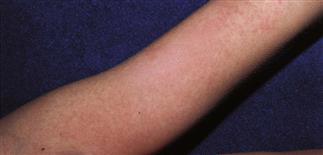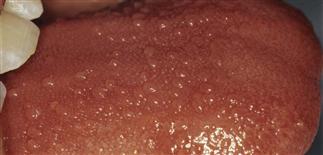
Red, rough maculopapular rash in child with scarlet fever.

Bright red (strawberry) tongue with prominent papillae in streptococcal scarlet fever.
CLINICAL FEATURES
Scarlet fever occurs in children between 2 and 10 years of age. Streptococci bacteria from pharyngitis or a skin wound are responsible. Twenty-four to 48 hours after the onset of clinical infection a generalized red skin change of macules, rough papules and some petechiae appears. Linear petechiae in the axillary and antecubital skin folds are seen as Pastia’s sign. The rough feel to the red skin is the result of goose bumps (arrector pili muscle contraction). Circumoral pallor is common. Palms and soles are uninvolved. A dry, red tongue with prominent papillae comprises a ‘strawberry tongue’. Generalized lymphadenopathy may be observed. As the eruption fades, fine desquamation appears. A severe septicemic form with hypotension is rarely seen. Three scarlet fever toxins from streptococci have been identified, all from M protein 1 or 3 containing strains.







